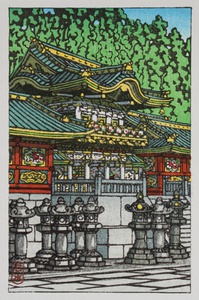| Method | Woodblock (nishiki-e) |
| Artist | Kawase Hasui (1883-1957) |
| Published | [c. 1930's] |
| Dimensions | Image 142 x 89 mm, Sheet 152 x 100 mm |
| Notes |
Seal: Hasui (type 10) Reference: Brown, Kendall: Amy Regeigle Newland, Kawase, Hasui: The Complete Woodblock Prints, Amsterdam, Hotei Publishing, KIT Publishers, 2003, pg. 147, Hp-77 (W-897). In addition to Hasui's main body of work consisting of over 600 prints, his work was issued in less conventional formats. Watanabe produced a selection of small prints by Hasui in three formats: octavo (approximately 85 x 130 mm), postcard (approximately 85 x 156 mm), and koban (115 x 177 mm) and they are collectively known as Hasui's postcard prints. They were first marketed in the Watanabe hangaten's (shop) 1931 sales catalogue and a number were listed in the 1936 Watanabe Catalogue. Some of the designs are recognisably derived from Hasui's full sized images and others seem to be specially designed to be produced in small format. They were intended for use as Christmas cards, the larger ones made into calendars or glued onto scrolls. The postcard prints are unsigned and only have Hasui's seal and generally do not have a publisher's seal. The image are often surrounded by white boarders. Other publishers also released small works by Hasaui including the the publishers Kato Junji and Bijutsusha. Kawasi Hasui (1883-1957)was the greatest of the shin-hanga printmakers and has become recognised as the best Japanese landscape artist since Hiroshige. In 1956, he was named a Living National Treasure in Japan, the highest honour a living artist could receive at the time. During his career he produced over 600 landscape prints, including seventeen series, covering most areas of Japan, in which he extensively travelled. Hasui was born as Kawase Bunjiro in Tokyo. His family owned a braided cord business in which Hasui worked in until his sister and her husband took over in 1908. Free of family responsibilities, Hasui could finally devote himself to art, which he had been passionate about since he was a child. In 1907 he began studying western-style art, especially landscape, at the Hakuba-kai (White Horse Society) and took guidance from Okada Saburosuke (1869-1939). In 1910 he became a pupil of Kaburaki Kiyokata who gave him the art name Hasui. At this time he earned his living through designing sashi-e, magazine illustrations, posters and patterns for sashes. Through Kiyokata he was introduced to Shōzaburō Watanabe who published his first landscape prints in 1918-19. Watanabe was the driving force of the shin-hanga movement and encouraged, supported, and promoted Hasui's career in Japan and abroad. From then on Hasui worked very extensively as a designer of landscape prints for Watanabe, and from almost the beginning inspired the carvers and printers to produce newer and subtler efforts, especially in the expression of snow. After the 1923 earthquake, in which he lost his house and his sketchbooks and almost all of his woodblocks, he was financed by Watanabe to go on a sketching trip to produce more series, and also worked occasionally for other publishers to eke out his income. Through the rest of his life, Hasui worked almost exclusively on landscape and townscape prints based on sketches he made in Tokyo and during travels around Japan. The vast majority of Hasui's prints were published by Watanabe Shozaburo, although he also occasionally worked with other publishers, including Doi Teiichi and Kawaguchi & Sakai. |
| Framing | mounted |
| Price | £300.00 |
| Stock ID | 44121 |

